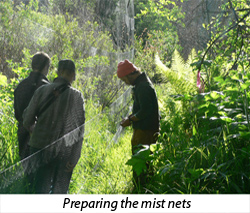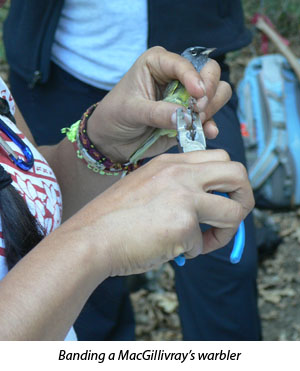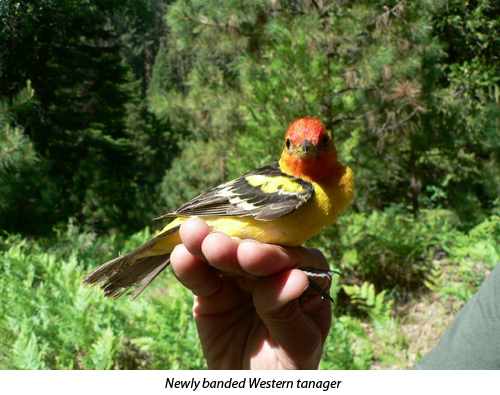The male Lawrence’s goldfinch dazzles with its shiny black face, gray back, and bright yellow chest, especially if your view is from just three feet away. I am in Hodgdon Meadow on June 12, 2014 with the bird researchers who are in charge of Monitoring Avian Productivity and Survivorship (MAPS), and this goldfinch is one of the 35 species the team has netted and measured in Hodgdon Meadow thus far this season. The researchers are here annually from the end of May until the start of August, and they monitor six meadow locations in five different elevation zones. In a ten day cycle they visit each meadow once and trap birds in fine mist nets. These nets, 12 meters long by 2 meters tall and more gossamer than a hair net, are suspended vertically from lightweight poles. Birds fly into the nets and are caught in the fine strands where they wait for the researchers to carefully gather them every 40 minutes. The birds are brought to a simple table holding a variety of scientific equipment including a scale, wing ruler, bird identification guide and a selection of bird bands. Each bird is weighed and measured, identified by species and aged by its plumage, and, if it arrived with bare ankles, is fitted with a shiny new bird band. All these data are carefully recorded and analyzed by the Institute for Bird Populations and stored in the national databank of the Bird Banding Laboratory.


The goldfinch I am gazing at arrived without jewelry, so I watch enthralled as the researchers size his leg. Once a bird has fledged from its nest, its leg has completed growing and a thin band of aluminum can be crimped safely and loosely around the ankle. This band is stamped on the outside with a unique 9 digit number, much like a social security number. On the inside of the band is the phone number and website for the Bird Banding Lab. If this goldfinch is recaptured in Yosemite or elsewhere, its number will be recorded and researchers can find out the approximate age of the bird and where it was banded. If anyone finds a dead bird with a band on its leg, the number from the band and the location where the bird was found should be reported to the Bird Banding Lab. They will send the reporter a certificate announcing where that bird was banded and if and where it was ever recaptured.

The MAPS project is celebrating its 25th year of research in Yosemite. With such a long data set, MAPS work enables researchers to learn more about the lives of Yosemite’s birds and the current trends in songbird populations. The park has the national longevity records for at least 7 species, including an 8 year old white-headed woodpecker and 9 year old MacGillivray’s warbler. We also know that an orange-crowned warbler banded here was recaptured in Texas, 1500 miles away!
Now the Lawrence’s goldfinch is banded and ready for release back to his mate, nest and territory. These birds are irregular visitors here, but they tend to follow drought and more have been seen in Hodgdon Meadow this year. What will this next year bring? Will this bird survive its migration south at the end of the summer, and will it return to Yosemite next year? Might next year’s MAPS researchers find it in another mist net and smile to see that it made the perilous journey north to breed once again?

Interested in learning more? Check out Part 2 of this topic in the next blog post.
